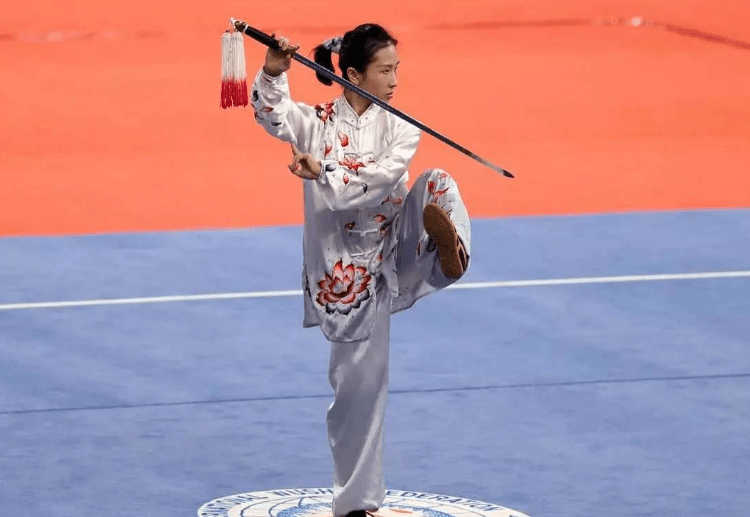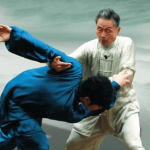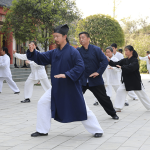The Tai Chi Chuan Sword is an important component of Tai Chi practice, combining the characteristics of Tai Chi and swordsmanship. On one hand, like Tai Chi, Tai Chi Chuan Sword requires to exhibit lightness, gentleness, continuity, and emphasis on intention rather than force. On the other hand, it also needs to demonstrate a graceful, agile, and clear style of swordsmanship, embodying both form and spirit.

How many types of Tai Chi Chuan Sword? What are they?
Here are some typical Tai Chi Sword styles:
- Beijing-style Yang Family Tai Chi Sword
- Wudang Tai Chi Chuan Sword
- Chen-style Tai Chi Chuan Sword
- Yang-style Tai Chi Chuan Sword
What are The Differences Between Tai Chi Chuan Sword and Tai Chi Sword?
Equipment Requirement:
- Tai Chi Sword: Primarily utilizes a sword as the equipment for practice.
- Tai Chi Chuan Sword Forms: Incorporates routines or practice forms that combine elements of Tai Chi and swordsmanship, rather than specifically using a sword for martial arts training.
Application Scenarios:
- Tai Chi Sword: Mainly employed in martial arts performances or competitions, emphasizing clear, accurate, and fluid sword techniques coordinated with body and footwork.
- Tai Chi Chuan Sword Forms: Integrates the essence of Tai Chi, used more for health and fitness purposes, as well as in practical combat situations.
Style Characteristics:
- Tai Chi Sword: Characterized by lightness, gentleness, continuous flow, and emphasis on intention over force, with graceful and clear sword techniques.
- Tai Chi Sword Chuan Forms: Emphasizes Tai Chi principles such as harmony of internal and external, continuity and fluidity, and the blending of softness and hardness, while incorporating elements of swordsmanship, creating a unique style.
Which one is Better? Tai Chi Sword vs Tai Chi Chuan Sword
- Comparing the formidability of Tai Chi Chuan Sword Forms and Tai Chi Sword is challenging due to their unique styles and individual characteristics.
- Tai Chi Chuan Sword Forms combine Tai Chi essence with swordsmanship elements, emphasizing principles like internal-external harmony, continuous flow, and softness-harness integration.
- Movements in Tai Chi Chuan Sword Forms are graceful, and fluid, and possess both aesthetic and combat value.
- Tai Chi Sword focuses on using a sword as equipment, emphasizing clear, accurate, and coordinated sword techniques with body and footwork.
- Tai Chi Sword exhibits characteristics of lightness, gentleness, and emphasis on intention over force, along with graceful and clear swordsmanship.
- Both Tai Chi Chuan Sword Forms and Tai Chi Sword can achieve high proficiency levels with proper practice and hold practical combat applications.
- Choosing the appropriate martial art form depends on personal interests and needs, with continuous skill improvement being crucial.
Which one is easy to learn for beginners?
- Generally, Tai Chi Chuan Sword Forms may be easier to pick up compared to Tai Chi Sword due to their combination of Tai Chi principles with elements of swordsmanship.
- Tai Chi Chuan Sword Forms allow those familiar with Tai Chi to better understand and grasp its essence and characteristics.
- Tai Chi Sword requires mastering specific swordsmanship basics and techniques, which can take time and effort.
- Learning Tai Chi Sword involves understanding sword grip, basic sword techniques, and coordination with body and footwork.
- The relative ease of learning Tai Chi Chuan Sword Forms or Tai Chi Sword depends on an individual’s background and interests.
- When choosing which martial art to learn, it’s important to consider personal circumstances and interests.
How to learn Tai Chi Chuan Sword for Beginners?
Understanding the Basics and Characteristics of the Sword
- Basic Knowledge: Understand the fundamental aspects of Tai Chi Sword, which blends Tai Chi principles with swordsmanship.
- Core Principles: Focus on internal-external harmony, continuity, and the balance of softness and hardness.
- Skills to Master: Learn the proper sword grip, basic techniques, and how to coordinate these with body and footwork.
Learning Basic Postures and Movements
- Foundational Elements: Start with learning basic postures and movements, including standing stance and sword grip.
- Importance: These basic elements are essential for building a strong foundation for further practice.
- Practice: Dedicate time and effort to mastering these foundational skills.
Practicing Sword Techniques and Body Footwork
- Technique Mastery: Once basics are learned, focus on practicing sword techniques.
- Coordination: Ensure that body footwork is synchronized with sword techniques to create a fluid and cohesive practice.
- Key Focus: Maintain balance and stability, and coordinate movements with breathing.
Watching Instructional Videos or Seeking Professional Guidance
- Instructional Videos: Use videos for detailed demonstrations and explanations of movements.
- Professional Guidance: Seek out professional instructors for personalized guidance and corrections.
Persisting in Practice and Continuous Improvement
- Long-Term Commitment: Tai Chi Sword requires perseverance and ongoing effort.
- Patience: Be patient and persistent in your practice.
- Continuous Improvement: Regularly summarize your experiences, aim to refine your movements, and improve your technical proficiency.

What are the Benefits of Learning Tai Chi Chuan Sword?
Physical and Mental Health
- Unity of Body and Mind: Emphasizes the connection between physical and mental aspects.
- Health Benefits: Promotes blood circulation, enhances cardiopulmonary function, and improves overall fitness.
- Relaxation and Stress Relief: Coordinated breathing and movements help regulate breathing, relax the body and mind, relieve stress, and improve sleep quality.
Improved Coordination
- Enhanced Coordination: Requires smooth movements and coordination of various body parts, improving overall balance and flexibility.
- Daily Life Benefits: Helps in preventing falls and increasing flexibility.
Cultivation of Character
- Character Development: Emphasizes both internal and external cultivation, leading to a stable and restrained temperament.
- Personal Growth: Enhances personal charm and confidence through long-term practice.
Enhanced Focus
- Concentration: Requires high levels of concentration and full immersion in movements.
- Daily Life Benefits: Improves the ability to handle complex problems and maintain efficiency in daily activities.
Strengthened Defense Ability
- Defensive Skills: While not primarily focused on attack, it teaches effective evasion and crisis resolution.
- Self-Protection: Enhances self-protection capabilities through practiced techniques and skills.
Cultural Experience
- Cultural Understanding: Provides a deep understanding of Chinese martial arts culture.
- Cultural Enrichment: Enriches personal cultural heritage and promotes international cultural exchange and understanding.
Social Opportunities
- Community and Networking: Participation in practice and competitions allows meeting like-minded individuals and expanding social circles.
- Learning and Improvement: Exchanging experiences with other practitioners continuously improves technical skills and practice experience.
More about Tai Chi


